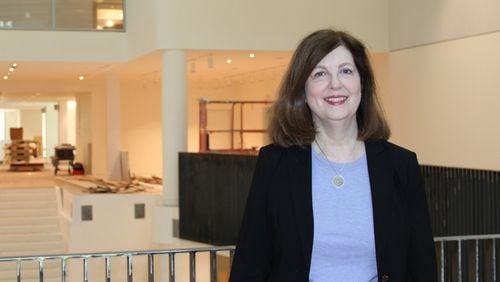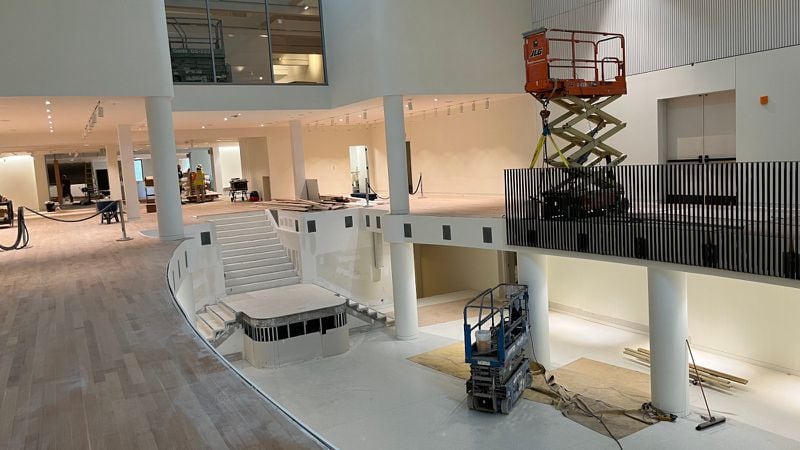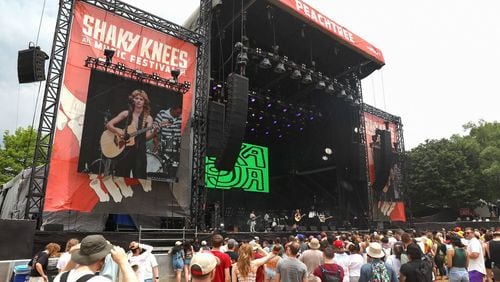COLUMBUS — Like night and day. The Columbus Museum — in Georgia, not Ohio — reopens in May with a dramatically different look.
The 18-month, $28.5 million renovation, financed by a capital campaign and $3 million in public funds, doesn’t add to the building’s already significant 89,000 square feet. But it does revolutionize the space.
Sweeping, brightly lit common areas and galleries replace dark tones, dim lighting and small, choppy spaces. The effect makes the museum’s interior nearly unrecognizable from its past. Architect Derek Jones’ goal was to create a sunnier, more spacious environment with a heightened focus on families. At the same time, the renovation allowed the museum to create better ways to present its noted art and history collections.
Gone is the more formal approach of the late 1980s, when the 70-year-old museum underwent its last major overhaul. This makeover removed virtually all decorative architecture, leaving a streamlined, wide-open space that’s intended to be more inviting.
“The point is that the museum is for everybody,” says Marianne Richter, the museum’s director since 2015. “We never intended to be intimidating, but museums, just by what they are, can seem intimidating, particularly to people who are not comfortable with them or accustomed to them. So we really want to make sure with this renovation — and I think we’ve done it — that the museum will be more user-friendly, more accessible.”
Credit: Jim Lynn/AJC
Credit: Jim Lynn/AJC
Across the country, many well-established museums — including those in New York (MOMA), Los Angeles (Hammer), Portland, Oregon, and Omaha, Nebraska — are undergoing or have recently completed redesigns intended to make them more approachable to more people.
Richter discussed the Columbus project’s goals in a makeshift meeting room next to the museum. A dozen or more construction workers were installing railings and lighting and finishing walls ahead of the planned May 4 public opening. “Overall, it’s going to seem airier, lighter and more spacious,” she said.
A dozen columns and arches that previously ringed the atrium have been removed, opening sightlines across the entire “galleria” space that runs nearly 100 feet long, almost 80 feet across, and 40 feet from floor to ceiling. Jones said his aim was to declutter the space. He removed “1980s unnecessary architecture” now considered out of vogue. Richter said those features were getting in the way of visitors being able to see art installations from different perspectives.
“There were a lot of postmodern elements that I’m sure were quite interesting in themselves,” she said. “But we’d want to put works of art in certain locations, and the columns were a bit of a challenge.” With the new design, pieces displayed in the atrium space can be seen from almost anywhere. In total, the renovation gives the museum 25% more exhibiting wall space without expanding the structure itself.
Gone are the dark floors, replaced in most areas with white oak and a light terrazzo. Lining large sections of common-area walls are slatted panels, giving the vast, white space much-needed visual texture, diffusion of sunlight and sound absorption. The look of the slatted wood treatment on the walls and ceiling is replicated in a steel railing, also painted white, around the atrium.
The new, larger entryway includes an orientation area, where visitors will be able to create their own tour by picking out descriptive cards that guide them along their way. Some of the cards will have viewing recommendations from Richter and possibly other Columbus public figures — sort of “here’s what I like about the museum, you might like it too” suggestions. Or, as Jones put it, “letting visitors be part of the curatorial process.”
A big part of the design challenge was melding the museum’s two distinct missions. One is, of course, to display its art. The museum’s large and varied permanent collection includes a Chihuly boat installation and a Nick Cave “Soundsuit” sculpture, abstract paintings by Alma Thomas, portraits by John Singer Sargent, landscapes by Marsden Hartley and figure studies by Benny Andrews. And there are loaned exhibitions, like Thomas’ “Everything is Beautiful” retrospective, which has been on tour at the National Gallery and other prominent museums and includes several pieces from the Columbus permanent collection.
Individual loaned pieces for the reopening include Andy Warhol’s “Silver Clouds” and the “Light is easy to love” painting by Amy Sherald, who also painted the well-known portrait of Michelle Obama now hanging at the National Portrait Gallery in Washington. Another exhibit features the work of 42 female artists with Southern connections.
But the other half of the dual mission is to tell an honest history of Columbus and the surrounding Chattahoochee Valley region, from the forced removal of Creek Indians to industrial growth powered by the Chattahoochee River, from the challenges faced by local suffragettes all the way to today’s changing neighborhoods, downtown resurgence, and the impacts of social movements in a town where minority residents are a plurality,.
Jones’ goal was to make the two parts flow like a single museum, rather than two mashed together. By removing a 1,600-square-foot theater, he created a more natural flow. Now the expanded history section is comprised of three large, separate but adjacent galleries named for their themes — Perseverance, Innovation and Growth.
“As we think about what museums do today, the challenge here was to bring together the two faces of the museum,” said Jones, who’s a part of the international Perkins+Will firm (perhaps best known recently for the Smithsonian’s National Museum of African American History and Culture). “For many (museums), it is one or the other but not both.”
Not far from the history wing is the children’s gallery, which might be the most impactful element of the new design. Museums generally see families as a key element in reaching educational and long-term audience development goals. Families in the museum also create a buzzy mood on weekends. Before the redesign, the Columbus Museum’s children’s section was hidden down a hallway in the far corner of the bottom floor. Now, the kids have prime real estate, with an expansive children’s gallery in the very front of the museum. The space includes an adjoining outdoor garden for children and their parents to enjoy play in an art-centered environment.
“The children’s location was an issue,” Richter noted. “Families are really important in getting lifelong visitors into the museum. It happens not just with school visits but also with family activities. So having the children’s location at the front makes it a better amenity for people to enjoy — and to come back to frequently — rather than being relegated to the basement.”
The removal of a large, earthen berm on the front lawn makes the museum fully visible from the street for the first time. Visitors will enter from the front of the building rather than the parking lot side, and a courtyard around the new entrance creates a space for people to gather.
Accompanying the building changes is a branding update, with a revised museum logo and the acronym COMU. Both are designed to soften the museum’s image, particularly for a younger arts audience.
As with most any project, there were some constraints, budgetary and otherwise. “We are living within the existing envelope,” rather than altering the exterior or making larger-scale structural changes, Jones said.
Still, Georgia has a museum designed for a new era. “Museums have traditionally been rarified spaces,” Jones said. “But this openness allows people to see what they’re getting into, and to feel comfortable in it.”
IF YOU GO
The Columbus Museum. Reopening May 4. 10 a.m.-5 p.m. Tuesday, Wednesday, Friday and Saturday; 10 a.m.-8 p.m. Thursday; 1 p.m. to 5 p.m. Sunday. Closed Monday. Free. 1327 Wynton Road, Columbus. 706-748-2562, columbusmuseum.com
MORE DETAILS
The Columbus Museum’s makeover at a glance:
Architect: Derek Jones of Perkins+Will, a large, international practice based in Chicago. The company’s portfolio includes the Smithsonian’s National Museum of African American History and Culture.
Cost: $28.5 million. $3 million from a Special Local Option Sales Tax, or SPLOST, approved by Muscogee County voters. The rest was raised in private donations through a capital campaign.
Size: 89,000 square feet.
Outdoor features include: Restored Frederick Law Olmsted garden, children’s garden, more visibility from the street, new entrance courtyard.
History: Opened in 1953. The former estate of industrialist W.C. Bradley, the property was donated to the city of Columbus in 1947 for cultural and educational use.
On view for the opening
The Columbus Museum’s opening shows are intended to “really make a statement about who we are and what we have to share,” museum marketing director Kristen Hudson said. Here’s a summary:
“Our Own Work, Our Own Way: Ascendant Women Artists in the Johnson Collection”
Forty-two women artists of the 20th Century with connections to the South, including Elaine de Kooning, Zelda Fitzgerald, and Alma Thomas, artists whose aesthetic achievements transcended social conventions and invigorated modernism in the South.
“Crossroads: Chattahoochee Valley Blues and Folk Music”
Features Gertrude “Ma” Rainey and Darby & Tarlton, plus local folk singers and rock bands. Exhibit highlights recording technologies and instruments through both artifacts and digital content.
“Andy Warhol: Silver Clouds & Cow Wallpaper”
An interactive installation on loan from the Andy Warhol Museum in Pittsburgh. Features a room full of floating pillow-shaped balloons, inflated with a mixture of air and pure helium, and Warhol’s Cow Wallpaper.
“A Decade of Drawings”
Thirty images from a variety of media. Included are works by John Singer Sargent, Burton Silverman, Marsden Hartley, Frederick Hammersley, Benny Andrews and William Beckman.
History of the Museum
This display spotlights the history of the estate of industrialist W.C. Bradley, an early Coca-Cola investor and philanthropist, the transformation of the estate into a museum, plus highlights of the museum’s permanent collection and noteworthy exhibitions over the years.
Special loans
“Light is easy to love,” by Amy Sherald, 2017, from the Nasher Museum of Art at Duke University.
“John Bascombe,” by Edward Troye, 1836. Troye was an American painter of thoroughbred horses. From the Yale University Art Gallery.
About the Author







